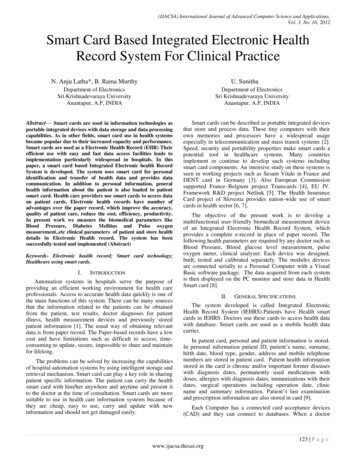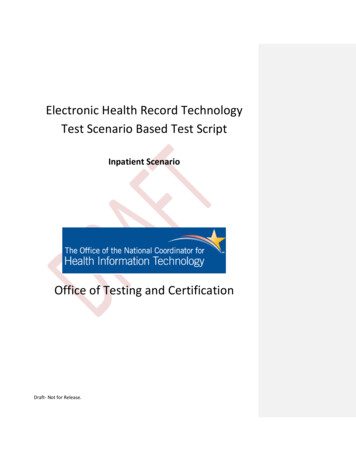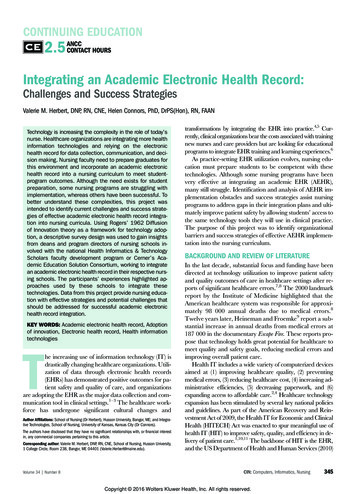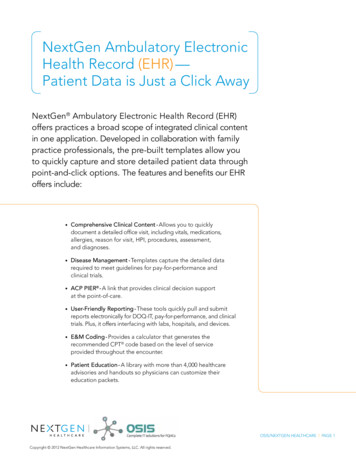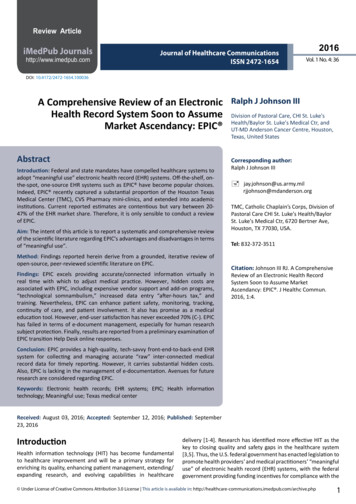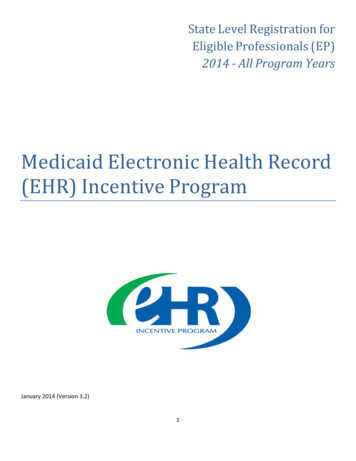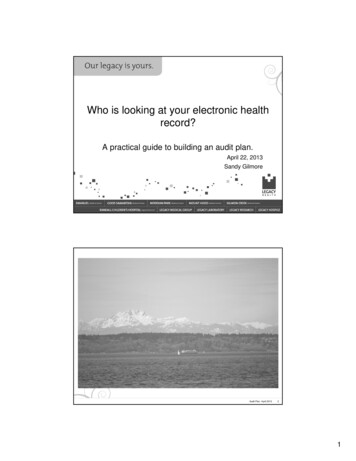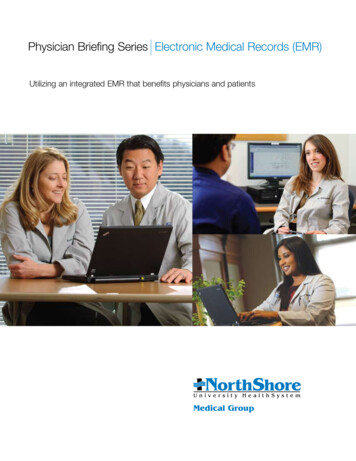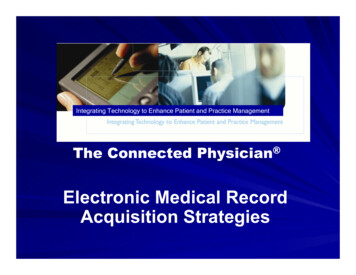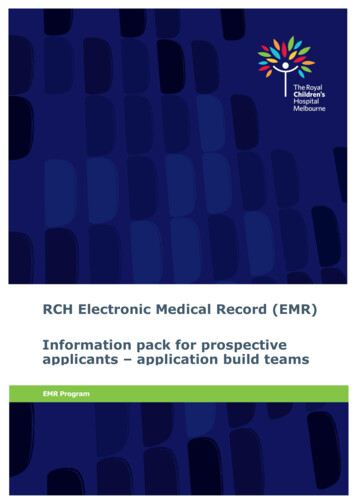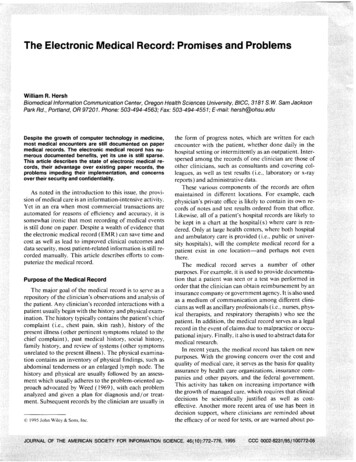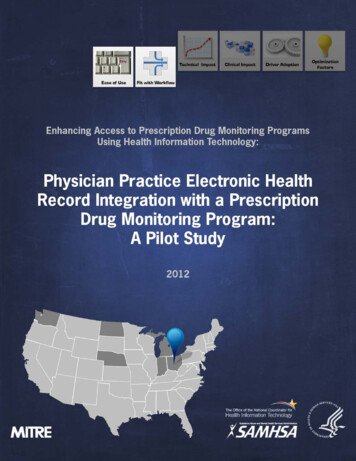
Transcription
Physician Practice Electronic Health Record Integration with a Prescription Drug Monitoring Program: A Pilot StudyPage 1 2012 The MITRE Corporation. All rights Reserved.Approved for Public Release: 12-4867. Distribution Unlimited.
Physician Practice Electronic Health Record Integration with a Prescription Drug Monitoring Program: A Pilot StudyOverviewGoalA pilot in Ohio that integrated a family medical practice with the Ohio Prescription DrugMonitoring Program (PDMP) demonstrated the value of health IT connectivity in an ambulatorycare setting by: Making PDMP data readily available to physicians (prescribers) during patientencounters through the practice electronic health record (EHR). Presenting PDMP data during existing patient care workflow.This pilot configuration showcased the workflow, ease of use, and added technical value ofimproved access to the PDMP in the ambulatory care setting by connecting the EHR to thePDMP and presenting patient-at-risk scores in the EHR. Patient-at-risk scores provideinformation about the probability that a patient is abusing prescription controlled substances;for this pilot, these scores were provided by a software solution called NARxCHECK.Pilot DesignThe Springfield Center for Family Medicine (SCFM) connected to Ohio’s PDMP, the OhioAutomated Rx Reporting System (OARRS), with SCFM’s EHR (the NextGen Ambulatory EHR).Eagle Software’s NARxCHECK system enabled the connection through HealthBridge, anindependent non-profit health information exchange (HIE). The EHR requested and refreshedthe data when (1) an appointment was scheduled and (2) when patients arrived for theirappointment. Figure 1 shows the pilot workflow, which illustrates the following steps:Figure 1. Pilot Workflow Diagram1. SCFM’s EHR queries the HIE upon patient appointment.2. The HIE routes the request to NARxCHECK.3. NARxCHECK requests the PDMP record.Page 2 2012 The MITRE Corporation. All rights Reserved.Approved for Public Release: 12-4867. Distribution Unlimited.
Physician Practice Electronic Health Record Integration with a Prescription Drug Monitoring Program: A Pilot Study4. The PDMP returns the record to NARxCHECK, which creates three Narx scores (3-digitrepresentations of the PDMP data).5. NARxCHECK passes the data through the HIE.6. The Narx scores are displayed in SCFM’s EHR patient record with a hyperlink to moredetailed patient information.Appendix A describes the pilot’s technical considerations, including the list of participants.Appendices B and C discuss the operational and evaluation considerations, respectively.ExperimentPre-Pilot StateThe Springfield Center for Family Medicine is a well-established family medicine practice with astable patient base. The prescribers typically know their patients’ medical history.In the “pre-pilot state” at SCFM: NextGen Ambulatory EHR is the principal health IT system used by the practice. Checking the PDMP is currently not part of the prescribers’ workflow because accessingthe PDMP:o Takes too much timeo Requires logging into a separate system outside NextGen Prescribers must perform multiple steps to access PDMP data via the OARRS portal. While prescription history data for controlled substances is available through the OARRSportal; there is no “score” indicating patient risk.Hypotheses and Specific MethodsThe following hypotheses directly relate to the six areas of interest that were the basis forevaluating the effectiveness of the pilots. Appendix D describes the evaluation methods indetail.Page 3 2012 The MITRE Corporation. All rights Reserved.Approved for Public Release: 12-4867. Distribution Unlimited.
Physician Practice Electronic Health Record Integration with a Prescription Drug Monitoring Program: A Pilot StudyTable 1. Hypotheses and Intended ImpactsArea of InterestIntended ImpactEase of UseThe Narx scores will provide prescribers with a concise view of theirpatients’ drug risk. The effort required to access the scores and PDMP datais minimized.Fit with WorkflowBy automatically integrating SCFM’s NextGen EHR system with theNARxCHECK system, SCFM prescribers will be able to view their patients’PDMP data in the patient record that is part of their day-to-day workflow.Technical ImpactLeveraging technical intermediaries, standards, and open-source softwarewill facilitate a cost-efficient implementation.Clinical ImpactHaving the PDMP data refreshed the day of appointment and available atthe time of decision-making with the patient improves decision-making.Driver of AdoptionThe reasonable implementation costs, coupled with the improved visibilityinto patient drug risk, will prove to be a compelling combination.Optimization FactorsThe system has additional opportunities to improve, and these can beidentified and enumerated.ResultsEase of Use and Fit of WorkflowBefore pilot implementation, the physicians rarely accessed the PDMP data because thisrequired them to exit the EHR workspace and then log on to the OARRS website to begin apatient search. The pilot configuration streamlined this process so that the technologyperformed the querying and processing tasks:1. Querying the PDMP – An automatic query was initiated when the patient scheduled anappointment; the PDMP information was updated when patients arrived for theirappointment, and their arrival was logged in the system.2. Processing PDMP Data – The patient’s demographic information was automaticallypassed from the EHR to the PDMP (via NARxCHECK) to perform the query.3. PDMP Response and Documentation – The associated risk factor generated byNARxCHECK was integrated directly into the patient record and was hyperlinked tomore detailed PDMP information.Technical and ClinicalDuring the study period of July 1 through July 31, 2012, a total of 7,504 patient encounterswere logged into the NextGen system. Because the system automatically requests patients’Narx scores both when an appointment is made and when patients arrive for theirappointment, a total of 12,119 queries were processed. The system logged 7,948 viewings ofthe Narx scores, 1,018 requests for full patient NARxCHECK reports, and 146 requests forpatient OARRS reports.Page 4 2012 The MITRE Corporation. All rights Reserved.Approved for Public Release: 12-4867. Distribution Unlimited.
Physician Practice Electronic Health Record Integration with a Prescription Drug Monitoring Program: A Pilot StudyThe system logged prescribers’ reactions to the data in two dimensions: whether the data mettheir expectations (for example, based on their clinical knowledge of the patient, did the reportdata match what they thought they would see?), and whether it was helpful to them.Table 2. Prescribers’ Reactions to the PDMP DataData met expectationsData did not meet expectationsNo answerTotalData Was HelpfulData Was Not 7,504Technical SystemThis pilot involved the following technical processes: Implementation of bidirectional admission, discharge, transfer (ADT) feeds to notifyNARxCHECK of patient appointments and arrivals Modification of NextGen display templates to display the Narx scores Modification of NextGen display templates to allow prescribers to review detailedpatient PDMP data Integration between Eagle Software and OARRS to allow Eagle to use OARRS toauthenticate prescribersDiscussionSeveral factors contributed to the successful implementation:Clinical ImpactAlthough SCFM prescribers reported that the PDMP data was helpful to them about 50% of thetime (3,748 times during the pilot test), it was expected that few of the patients over the pilotperiod would be at-risk patients. This result indicates that the PDMP data proved useful for50% of the patients who had care interactions with the physicians. Of these occurrences,prescribers indicated that the data did not match their expectations for 114 out of 3,748 “datawas helpful” responses. This is an important result as it indicates that even though SCFM’spatient population is stable, and therefore SCFM prescribers usually know their patients well,on average at least several times per day a patient’s PDMP data told an SCFM prescribersomething about their patient that they did not know and that was helpful to their medicaldecision-making.Page 5 2012 The MITRE Corporation. All rights Reserved.Approved for Public Release: 12-4867. Distribution Unlimited.
Physician Practice Electronic Health Record Integration with a Prescription Drug Monitoring Program: A Pilot StudyFit with WorkflowOverwhelmingly, prescribers reported that the PDMP data is now easier to access. One primaryreason for improvement is in the user interface implementation. The current implementationrequires that prescribers log-in to OARRS only once per day. Their session can then be sharedby OARRS and NARxCHECK. Single sign-on integration with NextGen would be preferable,however, as it would allow prescribers to access the detailed PDMP data without having tolog-in to any system other than NextGen.Technical Impact The prescribers’ knowledge and the developers’ skill contributed to successfulconnectivity. Appendix A discusses this in more detail, but in summary, both developerson this project showed outstanding skill and dedication. The ability to leverage and take advantage of current health IT was instrumental instreamlining the prescribers’ workflow. Industry standards (such as HL7’s ADT) andopen-source software (such as Mirth Connect) combined to provide the pilot test with apowerful accelerator. The ADT integration between NextGen and NARxCHECK wascompleted in a few days because open-source software (in this case Mirth Connect) wasavailable that already implemented the ADT feed standard. In the absence of thissoftware, the ADT integration would certainly have taken longer than it did, possiblyseveral weeks.Next StepsSCFM, Eagle Software, and OARRS plan to keep the connection active following the pilot.Other PilotsThe Enhancing Access to PDMP project conducted five additional pilots in Fiscal Year 2012which are available for review. The pilots encompass a variety of user groups, includingdispensers (pharmacists) and prescribers (ambulatory and emergency department) as well asdifferent technological solutions. These papers can be found at the Office of the NationalCoordinator for Health Information Technology (ONC) PDMP pen 512&mode 2&objID 3870.Page 6 2012 The MITRE Corporation. All rights Reserved.Approved for Public Release: 12-4867. Distribution Unlimited.
Physician Practice Electronic Health Record Integration with a Prescription Drug Monitoring Program: A Pilot StudyAppendix A. Technical ConsiderationsThis section contains a description of the pilot design, including participants and technologies.ParticipantsThe following parties participated in the pilot: Springfield Center for Family Medicine (SCFM) – A six-doctor private family practicefacility in Springfield, IL, established 25 years ago. Peter J. Muir, M.D., one of SCFM’sphysicians, implemented the changes to SCFM’s health information technology (HIT)systems. Eagle Software Corporation (ESC, http://www.eaglesoftware.com/) – A woman-ownedsmall business founded in 1994 and based in Dayton, OH. Eagle Software developsweb-based productivity enhancement tools for the legal and healthcare professions. HealthBridge (http://www.healthbridge.org) – A not-for-profit corporation thatsupports HIT adoption, health information exchange (HIE), and innovative use ofinformation for improved healthcare outcomes. Ohio Automated Rx Reporting System (OARRS, https://www.ohiopmp.gov/) – The Stateof Ohio’s PDMP, established in 2006 as a tool to assist healthcare professionals inproviding better treatment for patients with medical needs while quickly identifyingdrug-seeking behaviors.Relevant Technologies and ToolsThese principal technologies were vital components of the pilot. All were available prior to thepilot test, so no new core technologies were invented to conduct the pilot.NextGen Ambulatory EHRSCFM uses NextGen Healthcare’s NextGen Ambulatory EHR product to assist SCFM providerswith their patient care workflow. SCFM implemented NextGen in 2003 and has sincedeveloped substantial expertise in its implementation. Several NextGen features were useful tothe pilot test. First, NextGen stores its data in a commercial relational database managementsystem, which makes it possible to access the data for other purposes. The system integrationwith NARxCHECK, for example, accessed the NextGen database to learn about patientappointment and arrival events. Second, NextGen uses user-interface “templates” that allowedDr. Muir to modify the user interface to display patient Narx scores alongside other patientdata.Page 7 2012 The MITRE Corporation. All rights Reserved.Approved for Public Release: 12-4867. Distribution Unlimited.
Physician Practice Electronic Health Record Integration with a Prescription Drug Monitoring Program: A Pilot StudyNARxCHECK / Narx ScoresNARxCHECK is a software solution developed by ESC that provides three levels of service toclinical providers:1. An automated scoring system (Narx Score) that ranges from 000-999 and generallyrepresents the composite prevalence of prescription drug misuse risk factors within aPDMP report2. Automated “one-click” access to Narx Report and OARRS3. Care coordination ability between providers through the use of flags and notes thatcommunicate specific details about a patient’s prescription drug useFrom a provider’s perspective, the Narx scores were primarily treated as triage data, similar tovital signs, and used prior to seeing a patient to develop an awareness of overall prescriptiondrug use risk factors. The following approach is recommended for evaluating Narx Scores: 200Be Confident200-500 Be Curious 500Be CautiousThe patient’s record is unlikely to reveal a concerning pattern or level of use.The patient’s record may reveal a concerning pattern or level of use.The patient’s record is likely to reveal a concerning pattern or level of use.Mirth Connect Interface EngineMirth Connect is an open source cross-platform HL7 interface engine that enables bidirectionalsending of HL7 messages between systems and applications over multiple transports. It isavailable under the open source Mozilla Public License (MPL) 1.1.PostgreSQL (Structured Query Language) Relational DatabasePostgreSQL is a powerful, open-source, object-relational database system. It has more than 15years of active development and a proven architecture that has earned it a strong reputationfor reliability, data integrity, and correctness. PostgreSQL's source code is available under theliberal, open-source PostgreSQL License. This license gives users the freedom to use, modify,and distribute PostgreSQL in any form, open- or closed-source.Design OverviewThe pilot test development effort can be divided into three principal areas:1. A bidirectional HL7 admission, discharge, transfer (ADT) feed between SCFM andNARxCHECK (via HealthBridge) to notify NARxCHECK of SCFM patients and provide theirprescription drug risk data to SCFM2. User interface enhancements to the NextGen Ambulatory EHR to present the patients’risk scores to prescribers and allow prescribers to “drill down” into detailed patientcontrolled substance historyPage 8 2012 The MITRE Corporation. All rights Reserved.Approved for Public Release: 12-4867. Distribution Unlimited.
Physician Practice Electronic Health Record Integration with a Prescription Drug Monitoring Program: A Pilot Study3. Single sign-on integration between NARxCHECK and OARRSADT IntegrationAn instance of the Mirth Connect interface engine running in the SCFM office generates abidirectional HL7-format ADT feed. SCFM’s Mirth Connect interfaces to another Mirth Connectinstance running at HealthBridge over a persistent virtual private network (VPN) connection.HealthBridge’s Mirth Connect then passes the ADT messages to NARxCHECK. The ADT feedtransfers patient demographic data from SCFM to NARxCHECK and returns prescription drugrisk data back to SCFM, including the patient’s Narx Score and a link to a patient-specific webpage on the NARxCHECK system.User InterfaceSCFM modified its NextGen Ambulatory EHR to display the patient risk scores on the patient’sSubjective, Objective, Assessment, and Plan (SOAP) Notes page and Communication page. Therisk score was accompanied by buttons to allow prescribers to access detailed patientcontrolled substance data and fill out a feedback form to measure the effectiveness of the pilottest integration. The prescribers could access both a NARxCHECK report on the patient and thepatient’s OARRS report.Single Sign-onNARxCHECK and OARRS implemented a single sign-on integration to allow SCFM prescribers toaccess both OARRS and NARxCHECK data using OARRS credentials.Detailed DesignADT IntegrationFigure A-1 shows the flow of information between the components of this pilot.Figure A-1. Network TopologyPage 9 2012 The MITRE Corporation. All rights Reserved.Approved for Public Release: 12-4867. Distribution Unlimited.
Physician Practice Electronic Health Record Integration with a Prescription Drug Monitoring Program: A Pilot StudyWithin the NextGen EHR, a database trigger fires when an appointment is made and when apatient presents for an appointment. The trigger copies data from the main database into atable used specifically for integration with Narxcheck. This table contains one record perpatient with the following data: person id, last name, first name, middle name,date of birth, sex, street address, city, state, zip, create date, and modify date.The Mirth Connect interface engine polls this table periodically and, if new records are present,constructs and sends an HL7 A04 message to Narxcheck that indicates patient registration. Themessage contains the following segments: MSH (message header), PID (patient identifier), andPV1 (patient visit).This is a sample de-identified message:MSH \& SCFM002 NEXTGEN OH2752 SCFM Narxcheck OHPMP 20120713103438 ADT A04 20120713103438 P 2.5.1 NE NE PID 90895754-9A6A-40B1-9C48C3B1D1FE1C31 PN LASTNAME FIRSTNAME MI 19640125 M 1111 MAIN ST SPRINGFIELD OH 45502 PV1 R 1194763193 LASTNAME FIRSTNAME NPI 20120713103429 20120713103438 The message is sent over a persistent VPN to HealthBridge, where Narxcheck’s servers arelocated. The message is first processed by HealthBridge’s Mirth Connect instance and routed toNarxcheck’s servers.Upon receipt of the message, Narxcheck queries OARRS for that patient’s controlled substancehistory. If the patient demographics match a single patient, that patient’s history is returned intwo forms: structured data (used to calculate the NARx Score) and a PDF-formatted report in ahuman-readable format. Narxcheck then calculates the scores using a proprietary algorithmand formats a report for that patient.In response to SCFM’s A04 message, Narxcheck constructs and sends an HL7 OBX message,which indicates a result to SCFM. The message contains the following segments: MSH(message header), PID (patient identifier), and OBX (observation/result).This is a sample de-identified message:MSH \& Narxcheck Healthbridge SCFM002 NEXTGEN OH2752 SCFM ADT A08 634777724926866826 P 2.5.1 NE NE PID 90895754-9A6A-40B1-9C48-C3B1D1FE1C31 PN LASTNAME FIRSTNAME MI 19640125 M 111 MAIN ST SPRINGFIELD OH 45502 OBX 1 FT NARX 190.170.080 vm Page 10 2012 The MITRE Corporation. All rights Reserved.Approved for Public Release: 12-4867. Distribution Unlimited.
Physician Practice Electronic Health Record Integration with a Prescription Drug Monitoring Program: A Pilot StudyThe patient demographic data in PID is identical to the data received from SCFM, allowing thedata to be matched to the or
requires that prescribers log-in to OARRS only once per day. Their session can then be shared by OARRS and NARxCHECK. Single sign-on integration with NextGen would be preferable, however, as it would allow prescribers to access the detailed PDMP data without having to log

